#Battle of Delville Wood
Text
1916-Battle of Delville Wood

Battle of Delville Wood begins as an action within the Battle of the Somme, lasting until 3 September 1916.


The Battle of Delville Wood (15 July – 3 September 1916) was a series of engagements in the 1916 Battle of the Somme in the First World War, between the armies of the German Empire and the British Empire. Delville Wood (Bois d'Elville), was a thick tangle of trees, chiefly beech and hornbeam (the wood has been replanted with oak and birch by the South African government), with dense hazel thickets, intersected by grassy rides, to the east of Longueval. As part of a general offensive starting on 14 July, which became known as the Battle of Bazentin Ridge (14–17 July), General Douglas Haig, Commander of the British Expeditionary Force, intended to capture the German second position between Delville Wood and Bazentin le Petit.
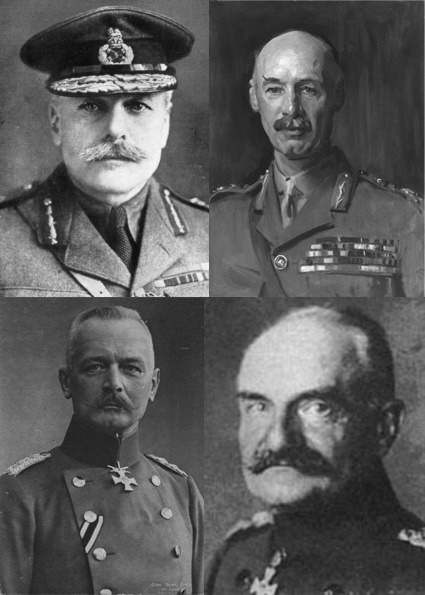
The attack achieved this objective and was a considerable though costly success. British attacks and German counter-attacks on the wood continued for the next seven weeks, until just before the Battle of Flers–Courcelette (15–17 September), the third British general attack in the Battle of the Somme. The 1st South African Infantry Brigade made its Western Front début as part of the 9th (Scottish) Division and captured Delville Wood on 15 July. The South Africans held the wood until 19 July, at a cost in casualties similar to those of many British brigades on 1 July. The village and wood formed a salient, which could be fired on by German artillery from three sides. The ground was a rise from Bernafay and Trônes woods, to the middle of the village, neither village or wood could be held without possession of the other. After the Battle of Bazentin Ridge, the British tried to advance on both flanks to straighten the salient at Delville Wood, to reach good jumping off positions for a general attack. The Germans tried to eliminate the salient and to retain the ground, which shielded German positions from view and overlooked British positions. For the rest of July and August, both sides fought for control of the wood and village but struggled to maintain the tempo of operations.
1 note
·
View note
Text
The Road to St. Julien: Letters of a Stretcher-bearer from the Great War :: William St. Clair
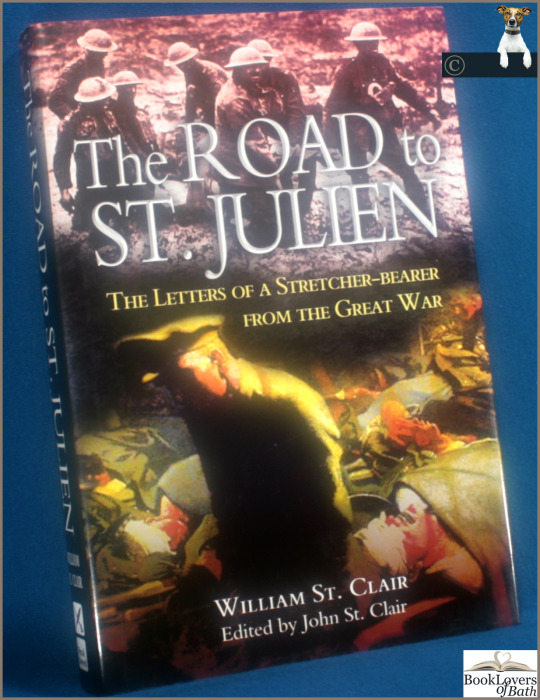
View On WordPress
#1-8441-5017-8#army biographies#army biography#army history#autobiographies#battle loos#battle somme#books by william st clair#british military history#delville wood#diaries#festubert#first edition books#john st clair#journals#memoirs#military history#passchendaele#royal army medical corps#scottish soldiers#soldiers correspondence#western front campaigns#world correspondence#world letters#world war i#world war one#wwi
1 note
·
View note
Text
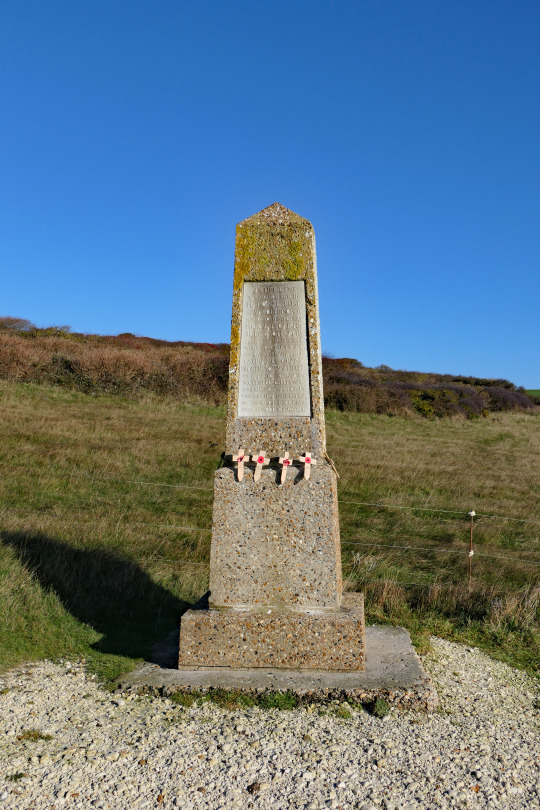

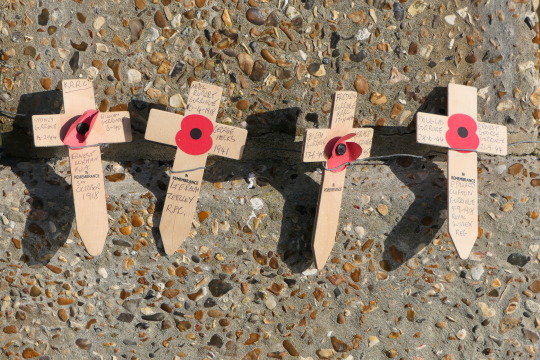
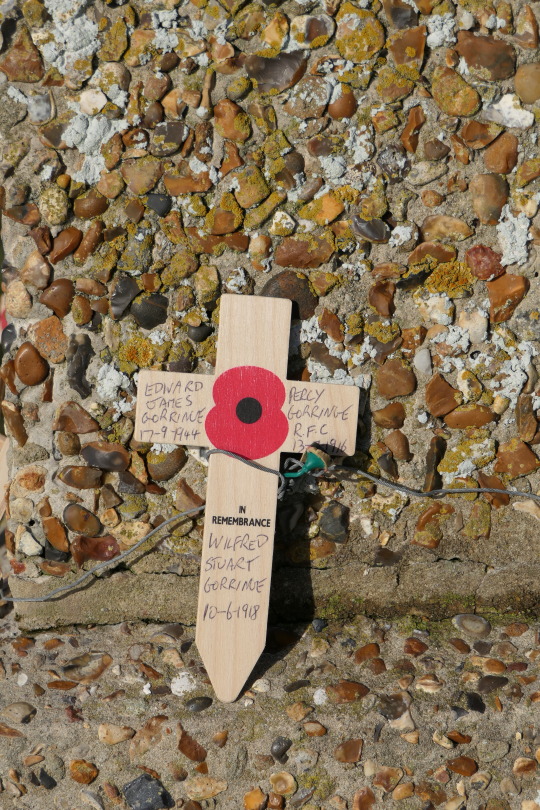
Monument uit de Eerste Wereldoorlog.
Dit monument staat ter nagedachtenis aan Norman Cains Robertson, kapitein van de 2e bataljon Hampshire Regiment. Hij sneuvelde op 20 juni 1917 in Hannover, Duitsland. Het monument herinnert ook Laurance Grant, 2e luitenant van het 2e bataljon King’s Own Scottish Borderes. Hij sneuvelde op 30 juli 1917 in Frankrijk, tijdens de slag om de Somme, in of vlakbij Delville Wood.
World War I Monument.
This memorial stands in memory of Norman Cains Robertson, captain of the 2nd battalion Hampshire Regiment. He was killed in action on June 20, 1917 in Hannover, Germany. The memorial also commemorates Laurance Grant, 2nd Lieutenant of the 2nd Battalion King's Own Scottish Borderes. He was killed in France on 30 July 1917, during the Battle of the Somme, in or near Delville Wood.
8 notes
·
View notes
Text


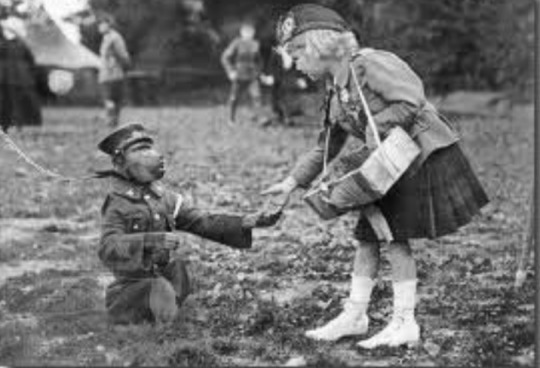
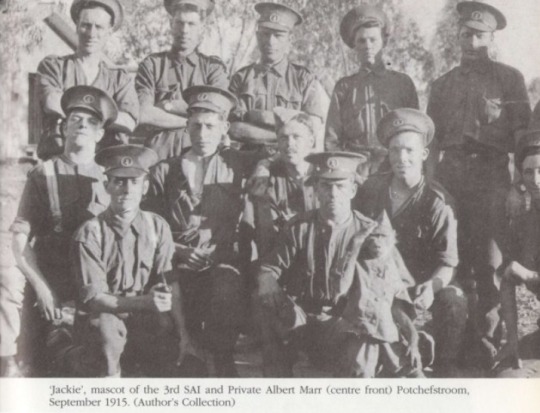
Corporal Jackie was a baboon in the South African Army during World War I.
He was the official mascot of the 3rd Transvaal Regimen when his owner Albert Marr was drafted into war and would not leave Jackie at home.
He asked his superiors if Jackie, too, could join the army and they said yes.
So Jackie was given an official style uniform with a cap, a ration set, and his own pay book.
Jackie would salute to superior officers and light soldiers' cigarettes. He would even stand at ease in the style of a trained soldier.
Due to his heightened senses, Jackie was useful to sentries on duty at night.
The baboon would be the first to know when an attack was coming or enemy soldiers were moving around nearby.
Jackie and Marr survived a battle where the casualty rate was 80%, in Delville Wood, early in the Somme Campaign.
When Marr was serving in Egypt, he was shot in the shoulder at the Battle of Agagia, 26 February 1916, while Jackie was with him, licking the wound as they awaited help.
Jackie was given his own rations while with the army and ate them with his own knife and fork, as well as his own washing basin.
When the regiment was drilled and marched, Jackie would be with them.
Jackie spent time in the trenches in France where he tried to build a wall around himself during extreme enemy fire.
However, a piece of shrapnel from an explosion flew over the wall hitting Jackie in the leg and arm.
When stretcher bearers tried to take Jackie away, he refused, desperate to finish his wall and hide.
Doctors treated Jackie's wounds, but they decided his leg had to be amputated and were surprised that he even survived.
Jackie was awarded a Medal of Valor for the event of his injuries and promoted from private to corporal.
After the war was over, Jackie was discharged with papers and went back to South Africa. He tragically died in a house fire in 1921.
#Corporal Jackie#baboon#South African Army#World War I#WWI#3rd Transvaal Regimen#Albert Marr#Battle of Agagia#Somme Campaign#animals#war hero#official mascot#Medal of Valor#South Africa
1 note
·
View note
Text
Events 7.14 (after 1900)
1902 – The Campanile in St Mark's Square, Venice collapses, also demolishing the loggetta.
1911 – Harry Atwood, an exhibition pilot for the Wright brothers, is greeted by President Taft after he lands his aeroplane on the South Lawn of the White House, having flown from Boston.
1915 – Beginning of the McMahon–Hussein Correspondence between Hussein bin Ali, Sharif of Mecca and the British official Henry McMahon concerning the Arab Revolt against the Ottoman Empire.
1916 – Battle of Delville Wood begins as an action within the Battle of the Somme, lasting until 3 September 1916.
1933 – In a decree called the Gleichschaltung, Adolf Hitler abolishes all German political parties except the Nazis.
1933 – Nazi eugenics programme begins with the proclamation of the Law for the Prevention of Hereditarily Diseased Offspring requiring the compulsory sterilization of any citizen who suffers from alleged genetic disorders.
1943 – In Diamond, Missouri, the George Washington Carver National Monument becomes the first United States National Monument in honor of an African American.
1948 – Palmiro Togliatti, leader of the Italian Communist Party, is shot and wounded near the Italian Parliament.
1950 – Korean War: beginning of the Battle of Taejon.
1951 – Ferrari take their first Formula One grand prix victory at the British Grand Prix at Silverstone.
1957 – Rawya Ateya takes her seat in the National Assembly of Egypt, thereby becoming the first female parliamentarian in the Arab world.
1958 – In the 14 July Revolution in Iraq, the monarchy is overthrown by popular forces led by Abd al-Karim Qasim, who becomes the nation's new leader.
1960 – Jane Goodall arrives at the Gombe Stream Reserve in present-day Tanzania to begin her study of chimpanzees in the wild.
1965 – Mariner 4 flyby of Mars takes the first close-up photos of another planet. The photographs take approximately six hours to be transmitted back to Earth.
1983 – Mario Bros. is released in Japan, beginning the popular Super Mario Bros franchise.
2002 – French president Jacques Chirac escapes an assassination attempt from Maxime Brunerie during a Bastille Day parade at Champs-Élysées.
2013 – Dedication of statue of Rachel Carson, a sculpture named for the environmentalist, in Woods Hole, Massachusetts.
2015 – NASA's New Horizons probe performs the first flyby of Pluto, and thus completes the initial survey of the Solar System.
2016 – A man ploughs a truck into a Bastille Day celebration in Nice, France, killing 86 people and injuring another 434 before being shot by police.
0 notes
Text
We will remember them

This morning we held our Remembrance services and came together as a community to remember the sacrifice made by former pupils and staff and to remind ourselves about our responsibilities to encourage peace and reconciliation. It was a very moving occasion with many contributions from pupils and staff.
As part of the service, our Deputy School Captains spoke about two former pupils who are listed on our Roll of Honour and I share their stories with you today.
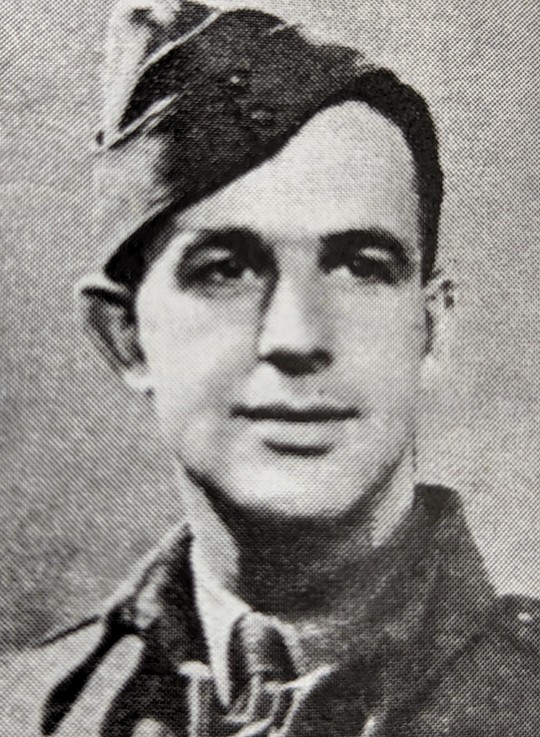
Towards the end of the Second World War, the Allies mounted an offensive against occupied Europe that started with the Normandy landings. Lieutenant Colonel Bernard Taunton was part of these landings and was killed while in the Channel. He attended Bablake between 1924 and 1930 and was captain of the 1st XV rugby team. During the war, he was mentioned in despatches for distinguished services and was promoted to Lieutenant Colonel. He had married in 1938 and the couple had two children.

Private Kenneth Barry was killed in France on 27th July 1916, aged 20. He joined Bablake in September 1907 and received a bursary to help him attend. After leaving, he went to Manchester University before enlisting into the army. The Battle of the Somme took place between July and November 1916 in Northern France and involved many soldiers from Britain and the Commonwealth. The South African Brigade was based in an area called Deville Wood and were joined by the Royal Fusiliers. During the fighting, Kenneth lost his life. His family appealed for information about him, but like many others, his body was never identified. He is commemorated on the Thiepval Memorial and in the Coventry War Memorial Park.
Many South Africans were killed at Delville Wood and it is now considered to be part of South Africa, even though it is in France. The area was replanted after the war and is now a peaceful place to visit and reflect. Towards the back of the wood, there is a remarkable survivor from the war, a tree. It stands as a reminder that even after such devastation, peace and reconciliation are possible. As a Cross of Nails School, we have a duty to promote these in our community, something that I believe is important part of the legacy of all those who served and serve on our behalf.
Andrew Wright
Headmaster
(Bulletin No 56 - 11th November 2022)
0 notes
Text
Speech by Peter Dickens on the Centenary of the Battle of Delville Wood
Thiepval Memorial, France 10th July 2016
Springbok Valour – Speech by Peter Dickens, Chairman of the Royal British Legion South African branch, in commemoration of 100 years of South Africans on the Somme and Battle of Delville Wood. Held at the Thiepval Memorial, France on 10th July 2016
“On behalf of The Royal British Legion South African Branch I would also like to welcome all here today, it is our privilege to honour the South African sacrifice during the Somme offensive – especially at Delville Wood just a short distance from this memorial.
We started this memorial service, with short blasts from World War 1 replica whistles, this was the signal blown by individual officers to send their troops “over the top” during the Somme Offensive and aside from the gun and artillery fire this is the last mechanical sound thousands of soldiers heard
Frightening isn’t it? The sound of these whistles had some men literally freeze in pure terror. What a harrowing and poignant start and to consider that it was a sound that was going to repeat itself again and again all along the Somme salient.
Why is the Thiepval memorial significant to South Africans? It’s a surprise to many in The Royal British Legion and in South African veteran and military circles, but the official designation of this memorial is the “Memorial to the 72, 195 British and South African servicemen, who died in the Battle of the Somme of the First World War between 1915 – 1918, with no known grave”.
This memorial is built right across the front lines as they stood on the 1st July 1916, the very same day the British Army suffered 20 000 men killed and a further 40 000 wounded – it’s literally on this very ground that we are standing on now that much of this massive bloodletting took place. Humbling – no doubt!
This memorial however, speaks not simply of that first day but of the whole Battle of the Somme. On stone panels around the memorial’s arches are recorded the names of the men of the United Kingdom, 71,336 and 858 South Africans.
There is also one Irish born South African Victoria Cross recipient listed – Captain Alexander Young, awarded the Victoria Cross during the Boer War, Young served with the South African Scottish Regiment and was killed in action in October 1916.
To, think – these are only the ‘missing’ from the battle of the Somme – men who have no known grave, or on whose gravestone is inscribed the words “unknown soldier”. As to names on actual headstones, around us are thousands. The Somme Offensive is off the scale – it is the most bloodiest battle in the entire history of mankind, – the sad truth – it advanced only 10 km along the front with the grim total of 1 million men dead or wounded from both sides littered in its wake.
And it all began with a Bang!, a very big one. Soldiers of the British Forces here and soldiers of the South African forces just over the way at Delville Wood witnessed the biggest explosion ever seen until then – The Lochnagar mine explosion was so big that debris from the explosion hit a British spotter plane 4000 ft up in the air, the detonation of this large mine and 8 others under German positions was said to be heard as far as England, and it was the start of carnage on a epic level.
On the South African side of the Somme Offensive things started off remarkably well, the 1st South African Brigade was ordered to advance and to capture Delville Wood on the 14th July and “hold it at all costs”.
At first the attack progressed smoothly and by the end of the day the South Africans had secured the wood, now spread along the perimeter in groups forming machine gun nests.
But, rather than having “secured” the wood, the brigade was now in a trap, with only the south western base in contact with the 26th Brigade in Longueval. All troops were equipped with spades but digging within the wood was made extremely difficult by roots and tree trunks, preparation of proper trenches was impossible, the South made do with shallow burrows. With these unprepared trenches just over 3000 South Africans faced over 7,000 German troops, holding the wood was going to be extremely difficult!
The Germans launched one of the heaviest artillery bombardments of the war in an effort to dislodge the South Africans. At its peak the rate of firing exceeded 400 shells per minute and to think this relentless volley of shelling for days on end, and it was into a wood no bigger than a square kilometer in size.
There is a reason there as so many “missing” South Africans listed on this memorial – this rate of artillery fire literally vaporized these men or blasted them beyond recognition. This is why Delville Wood itself is such a humbling experience – many of these men listed HERE are still THERE, unfound even to this day.
Of the 121 officers and 3,032 men of the South African Brigade who launched the initial attack, only 29 officers and 751 men eventually walked out. These men held the wood at a massive cost, even reverting to hand to hand combat at stages – the depth of bravery required to do this under this sort of fire power is simply too staggering to contemplate. The losses sustained by the South Africans were one of the greatest sacrifices of the war.
The South African Brigade suffered 80% loss, yet they managed to hold the Wood as ordered. This feat has was described then as “… the bloodiest battle hell of 1916.”
But something very important also happened during the Battle of Delville Wood – the South African nation as we know it today was born. It was out of this horrific baptism of fire, of South Africans from across ethnic, language and cultural divides – fighting as one in union and strength, that the newly formed Union of South Africa’s national identity was forged for the years come.
“Nancy” the Springbok, the South African Scottish mascot on the Somme, had been the symbol of home for all the men during the fighting, she proudly led four battalions of the South African Brigade to the first Delville Wood drum head service after the battle in 1918.
Prancing on her thin little legs, it’s almost as if she knew that she was the darling of every soldier on parade – and of those they were coming to honour – because from here on out these South African fighting men had walked into history as a force to be RESPECTED and the legend of the fighting Springbok was born.
The veterans bond
I would like, if I may, to talk about why is the Battle of the Somme, something that occurred 100 years ago, is so important to us as veterans?
Forgive me if I read an abridge version from these very poignant memoirs. One from a South African who had just survived Deville Wood in France in 1916, one from a survivor of the SS Mendi in 1917 and the other is from a South African who survived an air attack during Ops Modular in Angola in 1987.
Lance Corporal Frederick Charles Lee, the only surviving NCO in his company to come out of Delville wood.
“After five days of absolute awfulness poor Angus Brown, my pal, died of wounds after about three hours awful suffering. He had both feet blown off by a shell. I saw him a little while after he was hit. I gave him a drink of water, and the only complaint he made at that time was “My God, Fred, the pain is awful “. With that I ran down to the dressing station and got the doctor to give me some Morphine. When I got back Angus was just about finished’
The next from Matli, a survivor of the SS Mendi
“George Mathibe said to me when I found him, we are about to die, but one of us will live to tell at home how members of the tribe had died with the ship Mendi, and I hope it will be you’ at that point Matli gave Mathibe his warm great overcoat, promised to return to him but was unable to do so”.
70 years later, Cpl Dave Mannall, writes the following from Ops Modular after the Ratel 90 Infantry Fighting Vehicle next to his took a direct hit from a Mig fighter jet ‘s parachute retarded bomb:
“Frikkie De Jager died from multiple shrapnel injuries before the helicopters arrived, his death was extremely hard for us boys, watching that death slowly unfold over eight hours took a far greater toll on our morale, especially for all of us who had become brothers in arms with him during our year in 61 Mech”.
Although separated by 70 years, all these brave South Africans – Angus Brown, George Mathibe and Frik De Jager share a bond between themselves and that same bond is shared with us as their brothers in arms.
They all died in excruciating circumstances brought about by War but, most importantly, they all died in the arms of men would have gladly given their lives for them instead … and that is a very special bond indeed.
That bond of brotherhood stretches in countless names from Frikkie all the way to Angus, before and after. It is a bond that we all share, and it’s a bond that is never broken.
It really is not the job of Politicians to carry the flame of remembrance for our brothers, nor can they really understand the bond we have for them. There is no political currency to be made out the war dead, to do this is to absolutely dishonor them.
Because of this unique bond – It is our job – the job of the Veterans to carry this solemn flame of remembrance – this RED Poppy – it is our duty to carry that unique thread that links us here today with the men buried in the ground we are standing on and with those South Africans who where sacrificed nearby at Arques-la-Bataille or on the SS Mendi – even those who lie in graves far off in countries like Angola from a forgotten war … and we prepare to stand by those who WILL fall in the years to come.
Today! – our bond remains with those South Africans who fell in Delville Wood and those who where never found during the Battle of the Somme and are immortalized on this very monument – and after 100 years OUR bond is as strong as ever.
Lest we forget”
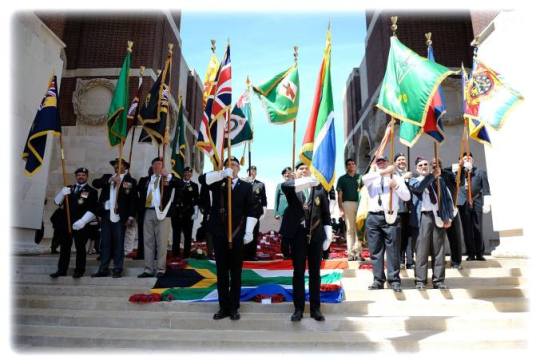
Springbok Valour Speech by Peter Dickens on the Centenary of the Battle of Delville Wood Thiepval Memorial, France 10th July 2016…
#Battle of Delville Wood#Battle of the Somme#Royal British Legion#Somme Offensive#South African Legion
0 notes
Photo
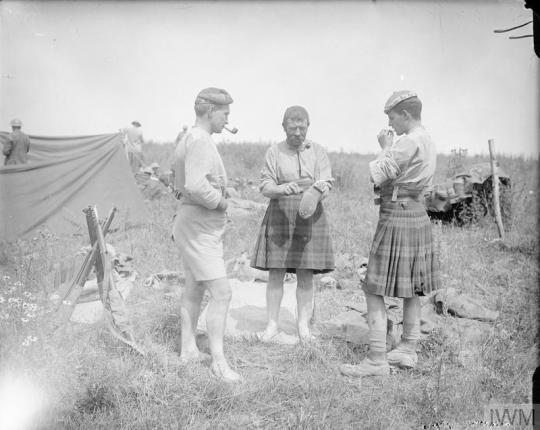
Battle of Delville Wood. Troops of the 4th South African Regiment (South African Scottish) after the attacks on Longueval. Montauban, July 1916.
27 notes
·
View notes
Photo
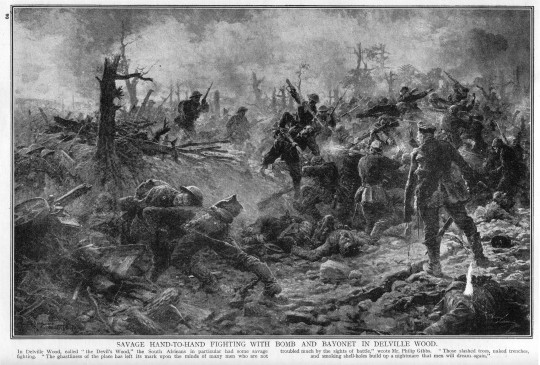
With 253 KIA OTD Jul 18 1916 is the deadliest day of #WWI for the South African Brigade. They were fighting during Battle of Delville Wood, or Devil's Wood. Drawing of the Battle Of Delville Wood from a book by H.W. Wilson
18 July 1916-07-18
Top Tenz 10 Deadliest Days on the Western Front
Top single day fatality numbers for the Western Front of WWI.
27,000 France Aug 22 1914
19,240 UK Jul 1 1916
10,851 Imperial Germany Mar 21 1918
2,414 Canada Apr 9 1917
1,230 AUS Jul 19 1916
847 NZ Oct 12 1917
500 Portugal Apr 9 1918
674 BEL Aug 23 1914
418 USA Oct 4 1918
310 Newfoundland Jul 1 1916
253 South Afica Jul 18 1916
For other theatres of war see:
Deadliest single days of World War I
14 notes
·
View notes
Photo
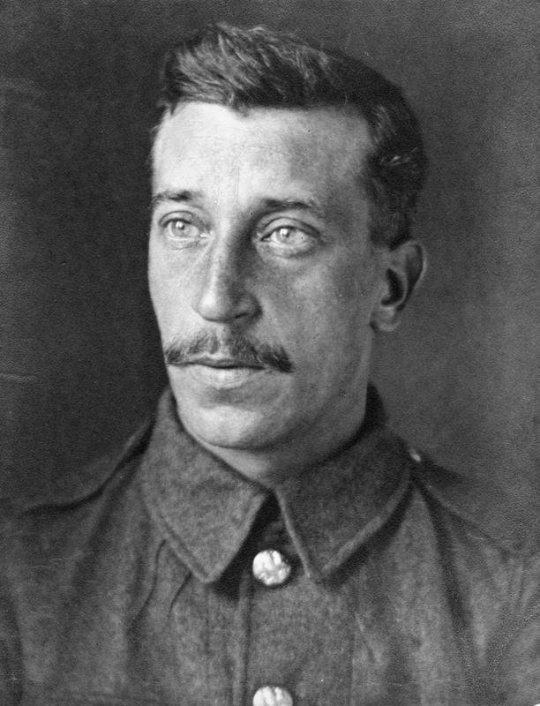
Private Bertie Frith Dinelli G/12369, 8th Battalion, The Queen's (Royal West Surrey Regiment). Death: 6th September 1916.
Son of Paul and Ellen Dinelli, of 2 Marlborough Road, Colliers Wood, Merton in Surrey. Reported missing, believed killed in action, aged 38, at Delville Wood on 6th September 1916 during the Battle of the Somme. At the end of the war in November 1918, his parents were still awaiting confirmation of his death. His body was eventually located and he is now buried at the London Cemetery and Extension, Longueval.
my source: https://thisdayinwwi.tumblr.com/post/187536255634/sep-6-1916-in-wwi
6 notes
·
View notes
Text
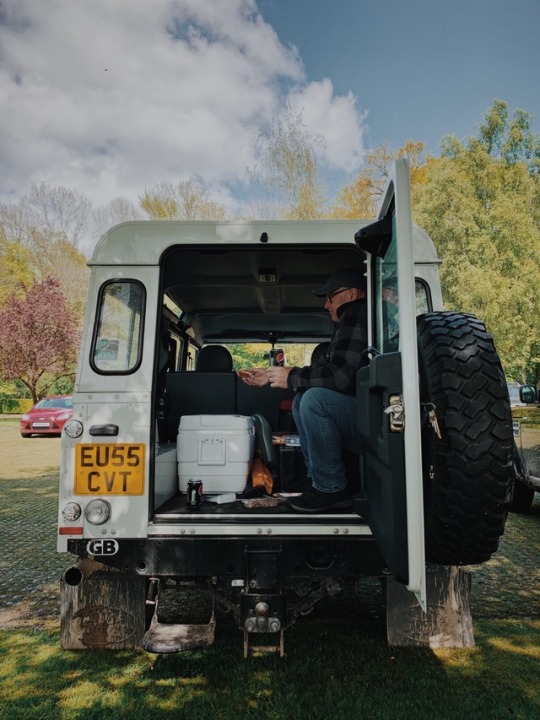
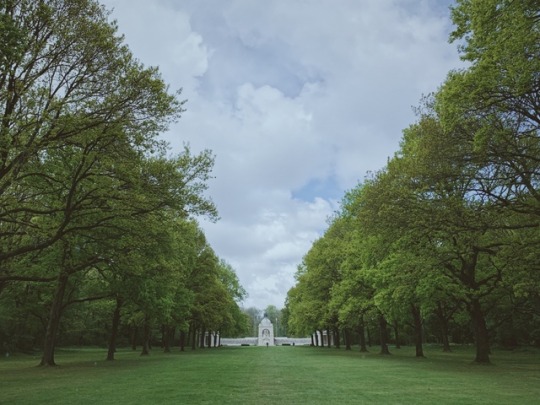
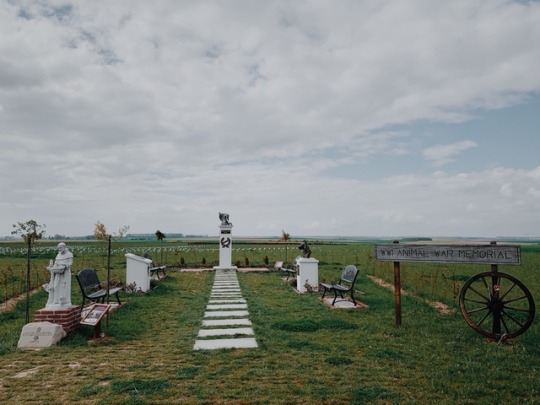

05/05/2019 - Day 2 (Part 2)
As we finish our cliche French lunch of cheese, bread, ham and cheese puffs we walk over to the cemetery over the road from the South African Memorial.
Delville Wood
Known as Devil’s Wood, as the fighting here was particularly ferocious. The majority of the wood was eventually taken by South African soldiers on the 15th July 1916, and they held it even after numerous German counterattacks for six days, until they were relieved.
High Wood
During the war ion some maps it was labelled as Bois des Foureaux french for “Wood of the Forks”. High Wood was of tremendous significance during the Battle of the Somme and were first attacked on 14th July 1916, but like many attacks in ww1 the British were unable to take it.
It was only until 15th September 1916 the woods were finally taken, On the 19th of September, the 47th Division which had lost more than 4,500 men was relieved by the 1st Division. Major-General Barter who commanded the 47th Division, was dismissed or wastage of men ironically though he was later knighted.
Pozières Memorial
Relates to the period between March and April 1918 when the Allied Army was driven back across the former battlefields, and months that followed before the victory. The memorial is now home over 14,000 casualties of the UK and 300 of the SA Forces who died on the Somme from 21/03/18 to 7/08/18.
Once we had finished at the Pozières memorial our day had finally finished and we headed back to the accommodation for food and rest.
#landrover#defender#landroverdefender#defender110#4x4#defendertd5#overland#overlander#td5#ww1#ww1 history#delville woods#high wood
12 notes
·
View notes
Photo

Today I am remembering my Great-great Grandfather Lance Corporal Thomas William Duckers of the 6650 1st Battalion The Royal Welsh Fusiliers, who was killed in action 28th August 1916 during the Battle of the Somme. He volunteered as a runner dispatching vital orders and information between the battalions on the frontlines, a terribly dangerous post as snipers often laid in wait and mines were set. He was reported missing in action-believed dead on the 28th after failing to report back to his regiment during the Battle of Delville Wood. His body was never recovered. He is commemorated on the Thiepval Memorial in France as well as our local cenotaphs. We will remember them.
#rl stuff#we will remember them#thomas william duckers#remembrance day#lest we forget#remembrance sunday#wwi#family stuff
4 notes
·
View notes
Text
War Graves, ANZAC Day & Paris
24-25/04/2018: Late start today as we intend to look around the war graves, do at least le Circuit du Souvenir and then rest before tomorrow's dawn service. Cecilia, with a day of rest behind her was keen to get out and look around.
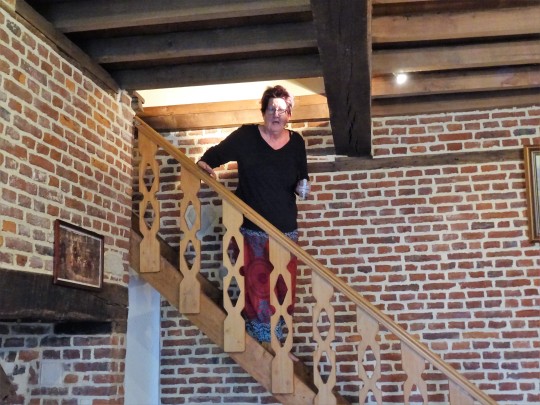
Raring to go
While we were all having tea and coffee with breakfast, Thomas decided to reverse his car out and reversed into Benoît’s horse truck ramp. Cockup five. It had been down since we arrived. Thomas didn't trust reversing cameras so he ignored the camera in the car. He then proceeded to reverse out and just clipped the end of the ramp putting a small tear in the tyre wall. And guess what? He didn't take out insurance for windscreens and tyres. Benoît suggested that we take it to a place in Varennes but to make sure that we had the best opportunity to get a new tyre, we headed to Amiens.
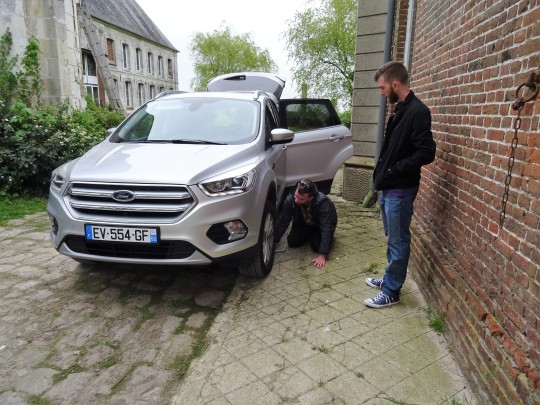
Where to put the jack
What an ordeal, we looked up some tyre places, entered Goodyear Dunlop into the GPS and we were on our way. The thirty kilometre trip went without a hitch until we were almost there. As went drove along Rue de Poulainville we were right next to a large factory. It had Dunlop France stamped all over their boundary fence and on a building or two. The actual address was in Avenue Roger Dumoulin just around the corner. When we were out front it was in fact another large factory. The GPS actually took us a few hundred metres down the road. When we got there, it told us to turn around and go back, which we did. After twenty minutes or so of chasing our tails we pulled into the Dunlop factory and asked for directions. They told us that they were the spot but didn't sell tyres. They pointed us to a place further down the road that sold tyres. Fine we thought and headed off.
The complex that we were in had a rather interesting past being much bigger around five years ago. The factory on the other side of the road had been making cheap tyres for years and doing their arse. After several attempts to restructure with different product lines and shift times, amongst court action and union resistance, they gave up and decided to close. The Texan CEO of Titan, another tyre manufacture who had recently pulled out of take over negotiations, questioned if Goodyear thought he was stupid when they suggested that they reopen negotiations. "The French workforce gets paid high wages but works only three hours. They get one hour for breaks and lunch, talk for three, and work for three. I told this to the French union workers' faces. They told me that's the French way!" was his reply. When the factory was on its final legs the workers took a couple of executives hostage. That didn't work either.
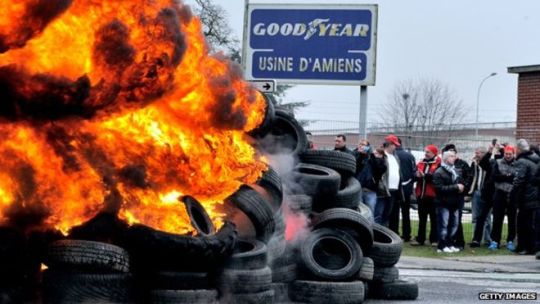
Typical French protest (Getty Images)
The next step was to find this tyre place. A couple of times up and down the road found it in a small factory complex at the back. We got the tyre out, rolled it into the work shop and waited for service. The dude behind the counter told us they only do truck tyres. Go around the corner to First Stop Tyres in Rue André Durouchez and they should be able to help. By this time Shane was fuming, actually, everyone was feeling pretty pissed off as the day was half over and instead of being well and truly on the war grave trail we were still trying to replace the bloody tyre. He and Tom packed the tyre back into the car and headed around the corner, unpacked the tyre and took it into the workshop. The dude come out, looked at it and said it would take three days to order one. At least we had an answer but not the one we wanted. "Try Norauto near Carrefour on Rue Botticelli". One last chance. We headed over to the northern end of town, pulled into the carpark and got the tyre out again. By this time Cecilia was starving so she, Jo and Beau headed in to look for lunch. They were soon joined by Thomas and Shane after again a knock back. Looks like we have to risk another flat and push on with no spare. After lunch, and Cec investing in an electronic cigarette setup, we were on the road again to take up where we were supposed to be hours earlier. The start of the Commonwealth Remembrance Trail, Le Circuit du Souvenir.
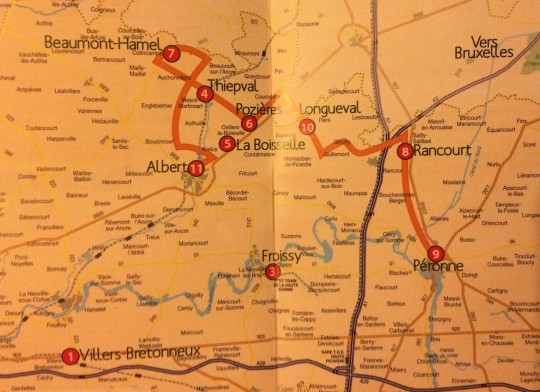
Le Circuit du Souvenir
We resumed our journey just before one and turned a leisurely day into a hurried one as the start of the trail, Péronne, was almost an hour away. When we arrived, we parked down the road and walked up the path to Péronne et l'Historial de la Grande Guerre, the Museum of the Great War and paid for a double entry, this one and Thiepval which we would visit later.
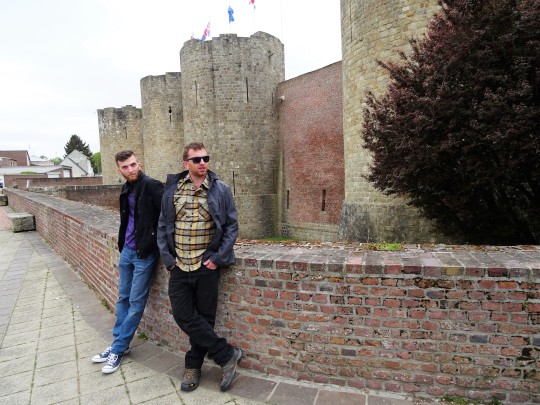
Waiting in Péronne
As with the last time we visited, the museum was really well equipped but with an extra section that was under construction. This time it was finished but we moved into the museum proper and left "The Guardrooms" until later. What immediately struck our eye was the old Saint-Chamond tank in the courtyard, a box on tracks with a small barrel at the front. Although crude in design, it must have been rather confronting for the infantrymen when they first encountered these things and a sign of things to come. As rudimentary as it was, it was the second French designed tank of the First World War, both heavier and longer than its predecessor. None exist today, they were all destroyed. This was in fact a replica.
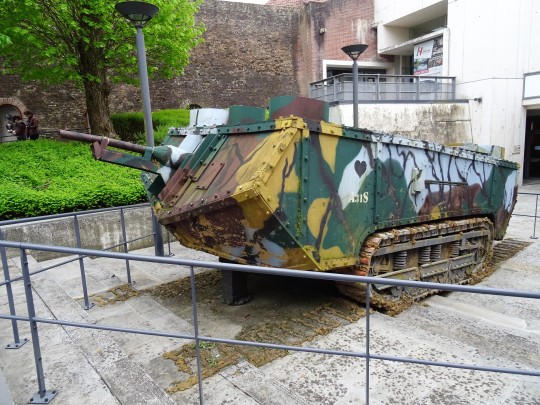
New addition to the courtyard, a life size replica by graphic and décor design students at Le Corbusier vocational college in Tourcoing. None of the originals remain.
The ramp to the left, leading to the entry was lined with helmets from throughout the ages, all contained within the niches of the fortress walls. Once in, we showed our tickets and entered into the Salle Avant-guerre, the first room containing militaria and chronological history of events that led up to the war. This led into two central galleries, Salle 1914-1916 and Salle 1916-1918. To the side was Salle Bataille de la Somme, a small theatrette that showed a thirty minute film of the Battle of the Somme. The galleries dealt with the first and second halves of the Great War respectively. In the centre of each were displays of weapons and military equipment from the period, recessed into the floor. Salle 1914-16 displayed mannequins dressed in the uniforms of the nations represented at the front with all their kit, personal weapons and creature comforts such as musical instruments. Support staff, nurses and medics were also there. Salle 1916-1918 was similar but concentrated on the heavier weaponry used at the front. Both galleries were surrounded by glass cabinets with paraphernalia from the period and audio-visual stations with film monitors, sound archives, and touch screen tables and tablets scattered throughout. The display was from three separate perspectives, German, French and British.
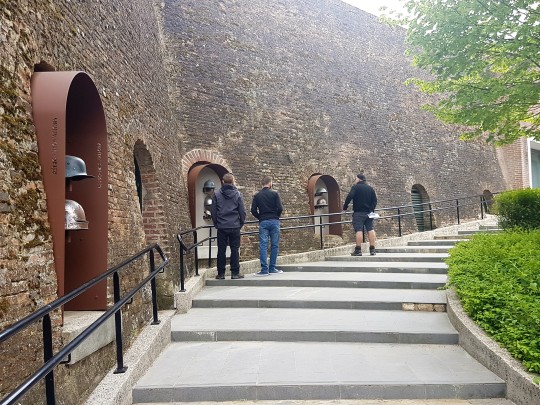
Helmets fill the niches
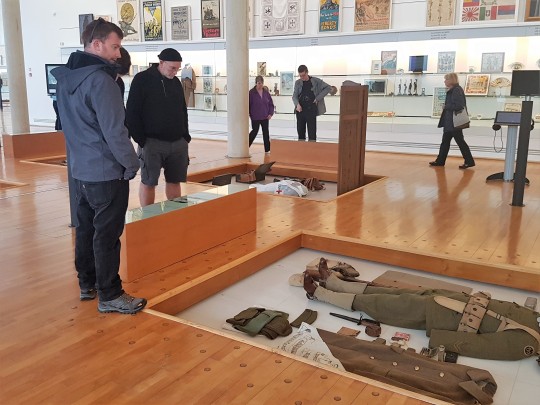
Salle 1914-1916
As we headed towards the exit, we took a look at Salle Otto Dix, a room dedicated to the German soldier and artist. On display were representations of his Der Krieg series of prints depicting his experiences of the horror of the war. Very dour. The last room before leaving was Salle Après-guerre showing items, posters etc that were displayed or recovered after the war.
As we left the galleries and re-entered the castle's courtyard, The Guardrooms were down to the left. There were four permanent exhibition areas namely, Castle of Péronne, Sentry over the Somme showing the evolution of the castle and its relationship with Péronne throughout history, Péronne, a Stronghold on the Border which was an audio visual animation of the city's wars and sieges over the ages, A Territory Caught in the Grip of War, photos of the area during and immediately after the war and the one we were most interested in, Australians and the Battle of Mont Saint-Quentin. This room was really good with maps and photos of Aussies during their taking of Mont Saint Quentin.
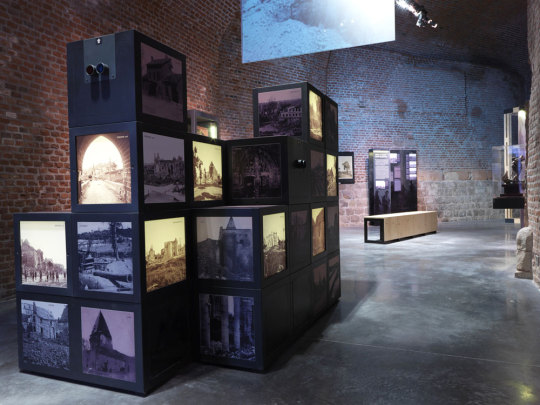
Salle-des-gardes-Australiens-©-Pascal-Brunet
After the visit we jumped back in the cars and headed a few kilometres further, through Bouchavesnes-Bergen and green fields to the next stop on the map, Rancourt. This area experienced heavy fighting during the last three months of the Battle of the Somme where the 32nd French Army Corps took on the Germans with the intention of penetrating their communications line between Bapaume and Péronne. They managed to do so, finally stopping at Saint-Pierre Vast Wood nearby during November 1916. One of the many fallen was Jean Du Bos, Second Lieutenant in the 94th Infantry Regiment. His parents commissioned the French Chapel of Remembrance fronting the roadway in 1923 in memory of he and his mates.
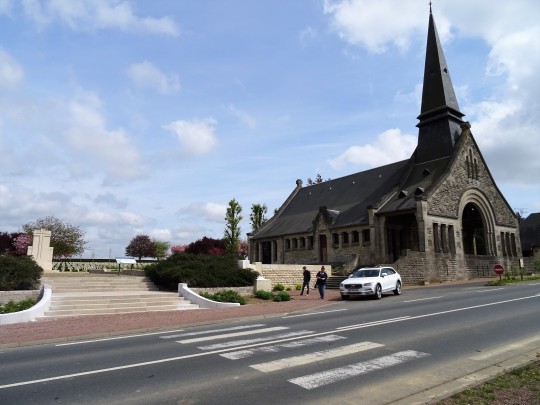
“Souvenir Français” Chapel of Remembrance
We stopped here for a while, walking through the cemetery where over eight and a half thousand French soldiers are buried, a simple white cross symbolising their sacrifice. Just a paddock away was the Rancourt Deutscher Soldaten Friedhof, the Rancourt German Soldier's Cemetery where almost ten and a half thousand Germans are buried, several thousand in mass graves. Straight across the road behind a small cottage was a British cemetery holding about eighty.

Simple white crosses. La nécropole nationale de Rancourt
It was then onto Delville Wood. The memorial impressed us a couple of years ago so another visit was a must. Thousands of South Africans died here during 1916 pushing back the Germans in the Battle of Delville Wood. More battles were fought here during the German spring offensive of 1918 but most met their demise during the original confrontation. The place was obliterated by shelling during the battle that saw almost nothing remain, bar one tree. Jo left the final of the school kid crosses from Tilegry primary school here. So many men died in the bombardment that thousands still rest beneath the replanted forest that is there today. First stop was the cemetery and then up Central Avenue toward the Memorial Arch in the distance. The wide avenue and oak lining gave a great sense of tranquillity. The trees were part of the restoration of the wood in the 1920's and were germinated from acorns collected in Franschoek. The person responsible for the restoration came from there and asked a local boy to collect a bag full of acorns from a tree that had germinated from acorns that French Huguenot Jean Gardiol had brought to South Africa in 1688.
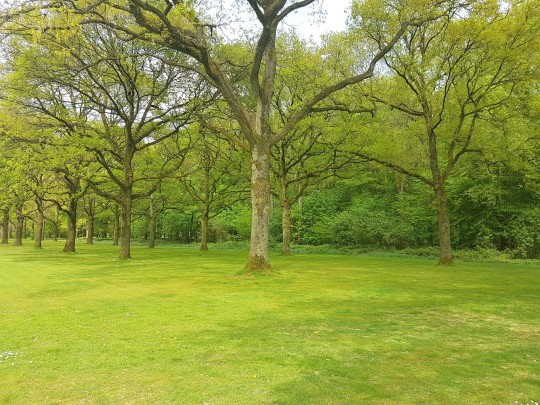
The double row of oak trees lining Central Avenue
The memorial and museum were accessible this time. Shane and the boys went in for a look, Jo and Cec looked around outside, revisiting the tree that survived the whole ordeal, Aussie crosses and other nations’ symbols resting on the trunk. Although it was behind the main complex, it seemed to be in some way the centre of it all.

The Last Tree. Still there
The path went through the memorial arch and beyond to the museum. Whilst the memorial was built around 1926, not long after the war, the museum was built by 1986 and built around the Cross of Consecration. It was designed around the Castle of Good Hope in Cape Town, the first European fortification erected in South Africa. The pentagonal building has full internal glass walls with the cross solemnly on display.
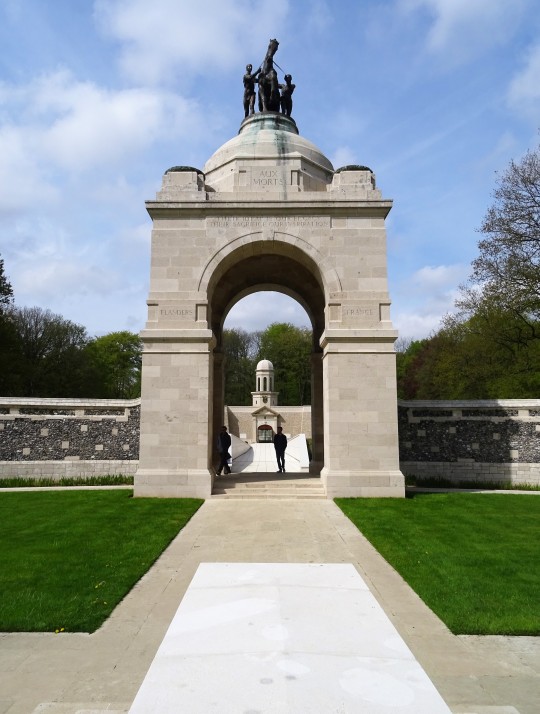
Looking through the Memorial Arch toward the museum.
Built to commemorate the sacrifice of around twenty five thousand South African service men and women of all races who volunteered to fight for their country in both World Wars and in Korea, the displays included remnants from the area as well as large bronze reliefs depicting the history of battle. The front doors opened and immediately before us was a large glass etching of Delville Wood after the battle. Directly behind the etching was the Cross of Consecration in a central courtyard that we were excluded from. Just to the side was a roll of honour from one of the wars and to the left of the roll was the displays of the memorial, bronze reliefs, a glowing glass representation of the scorched earth and plenty of photos and stories.
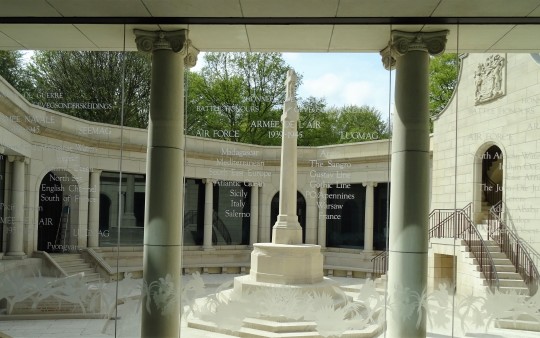
Cross of Consecration

1914-1918
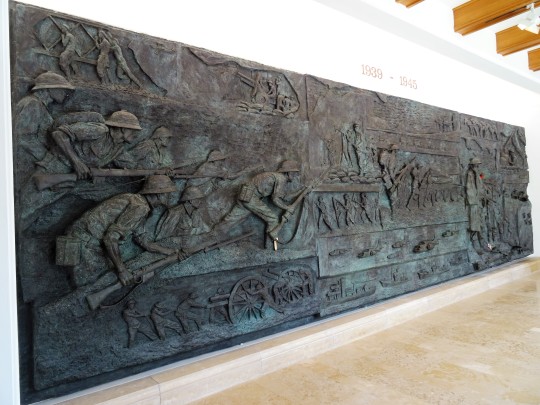
1939-1945
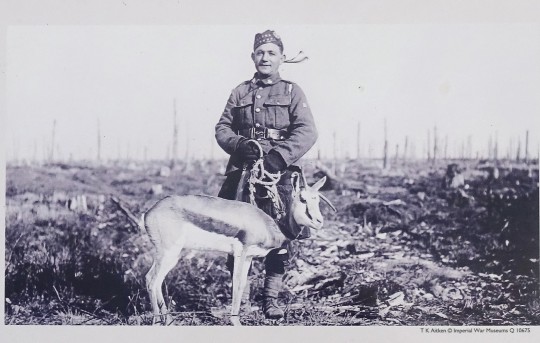
Nancy the springbok, mascot of the 4th South African Regiment in 1918, almost two years after the battle.
The next step was to find Jo and Cec. We thought that that they would have been for a walk around but not to our surprise, Jo was still looking around while Cec was sitting near the arch having a vape. We revisited the oldest tree in the village and then had to move on. The day was escaping us.

Cec vaping beneath Castor and Pollux
Our next stop was a brief one at Windmill Hill, which now included a memorial to the fallen animals, and then on to a big one, the British Memorial to the Missing at Thiepval via the new museum, the second half of our two for one deal at Péronne. The memorial arches contain the names of over seventy thousand soldiers whose remains were never found or unidentified and its kept that way. If the remains of a soldier is found by locals going about their business and is identified, the soldier is given a full military funeral at a cemetery near where they were found. Their name on Thiepval Memorial is then filled in. On the way back to Clairfaye, we stopped for one more memorial, one which we couldn't find last time. The Beaumont-Hamel New Foundlanders' Memorial was just about to close when we pulled up. Just past the information centre was a pathway through the fields that had been preserved as they were left after the war. Trenches everywhere giving a good perspective of the landscape of the day, without the rain and mud. To the side was a large rocky mound with the statue of a caribou where one could ascend the path to the top and look over the battlefield where so many died.

Some tranches had small boardwalks for stability but most didn't
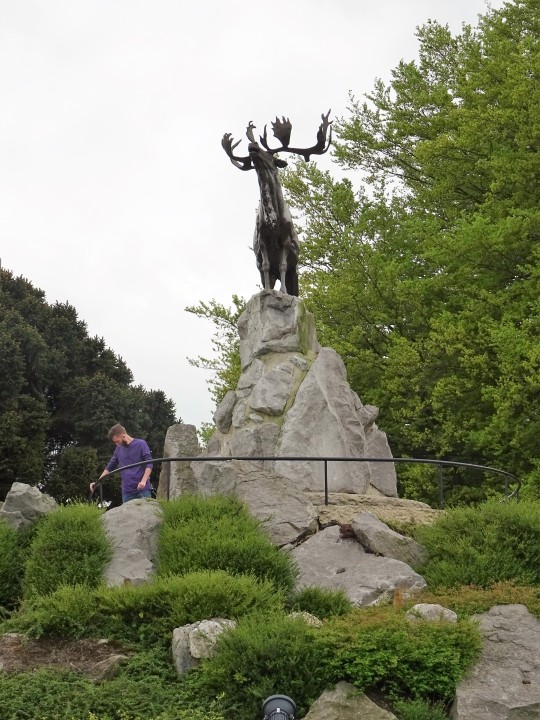
Beau on the memorial
That was it for the day, back to the apartment for a rest before tackling the dawn service. Just a rest, not a sleep as there was too much to do. The rush, or semi-rush was on as with Joanne and Cecilia laying a wreath, we had to be early, so the next few hours were spent eating, relaxing, packing and cleaning. Our agreement with Benoît through Airbnb was that we had to vacate by mid morning but we would still be in Villers-Bretonneux. Luckily there was no one booked in the next day. It was fine with him to leave our gear inside the apartment to collect after the morning was over. The twenty odd kilometres back verses the loading of all of our belongings that night and leaving the vehicle in a carpark was a no brainer.
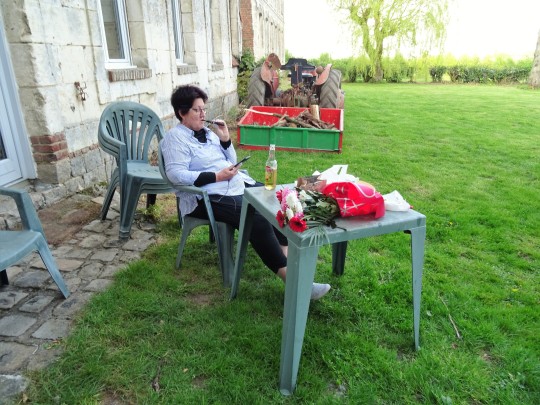
Cecilia preparing for the dawn service
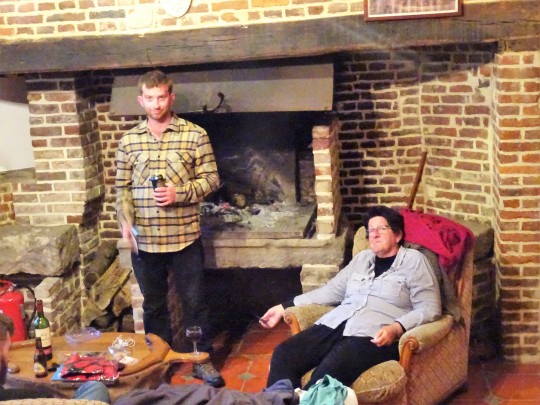
Thomas and Cec preparing for the service
Ninety percent packed, we headed out at eleven o'clock towards the township of Glisy, where we parked up the Volvo and joined the waiting game to go through security and onto the shuttles. The place wasn't even open yet but the queue was long and as expected soldiers everywhere. Once onboard, we headed straight off as the buses filled quickly.

Inside the security tent
Almost as soon as we left, Jo received a phone call from ABC Radio which had been a couple of days in the planning. She gave an interview on 2NC about where we were and why we were there, talking about Henry Ringland and the whole ANZAC Day experience so far. Apparently, messages from home said that she sounded good.
The greeting at the Australian Memorial was as expected, queues of people waiting to get scanned. It was okay though as we felt safe with all of the security around. Terrorists are after all cowards, and look for soft targets. There were no such targets here.
Out of the scanning marque, and for the second time on our trip, we walked up amongst the headstones leading to the cenotaph. It was cold, and although not wet, we were nervous about a downfall soaking everyone to the bone. Little sacrifice with what those before us, and the reason why we were there, went through. We were welcomed by Aussie support staff with some comforting goodies once we reached the action area. To our left was another marque, full of tea and coffee, pastries and water. We were set and grabbed a seat in a pretty good spot reserved for descendants and wreath layers, we were both. By two o'clock the entertainment started. The Army brass band and an accompanying choir. By five thirty, the service commenced.
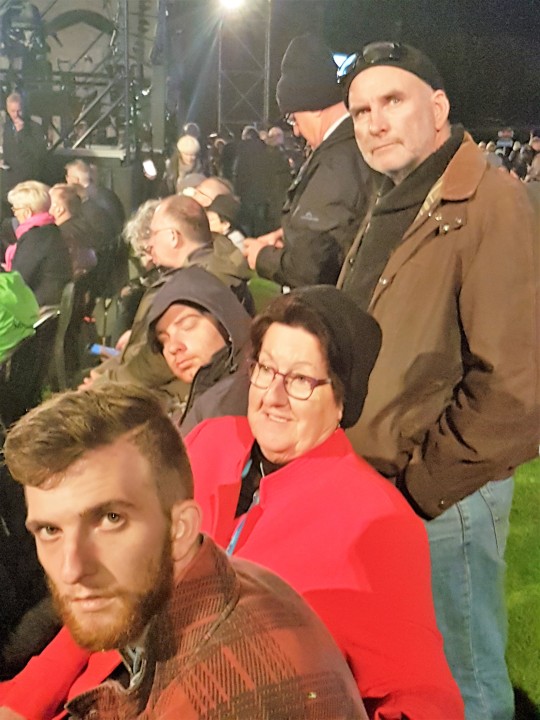
Waiting for it all to start
Amongst the VIP's were several pollies, the Prime Minister and some underlings including Tony Abbott, the Governor General and Prince Charles. The service was very moving, starting with a short film, an extract from a movie called "The Telegraph Man". This brought everyone to tears with Jack Thompson being the local postie in a small town during the war and everyone dreaded him coming anywhere near them as he only ever had bad news, namely a telegram reporting their sons' deaths. This was followed by soldiers faces, posing before they left for battle and dressed in their uniform, posing with their families or out in the battlefield. All projected onto the white face of the tower. After the speeches, the final part of the ceremony was the Last Post, performed by a lone bugler from the top of the tower. It would have rung across the valley, what was once the battlefield where many, many lives were lost. Very poignant indeed and underpinned by a shower of rain before the final act, wreath laying.
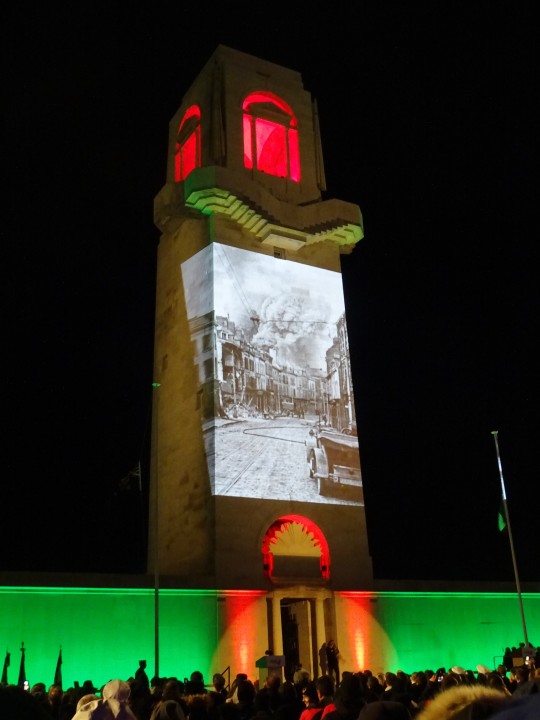
The service begins
Once the officials had laid their wreaths, it was the turn of the direct descendants and general public to lay flowers. When prompted, Jo and Cec walked up to the steps of the tower and laid the flowers and a wreath for Uncle Henry Joseph Ringland. Originally Jo, Cecilia, Beau and Thomas were going to lay the flowers but an email restricted it two people per family. Jo regrets leaving the boys behind as other families had more people out there.
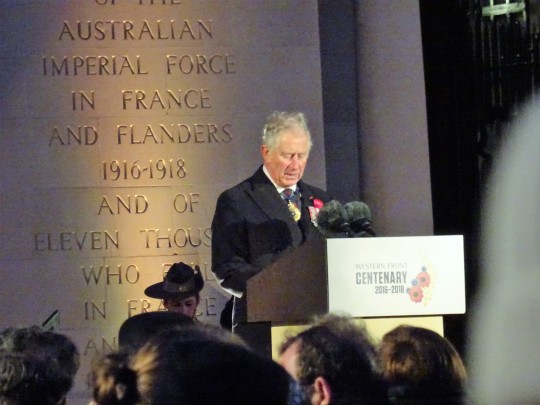
Prince Charles saying a few words
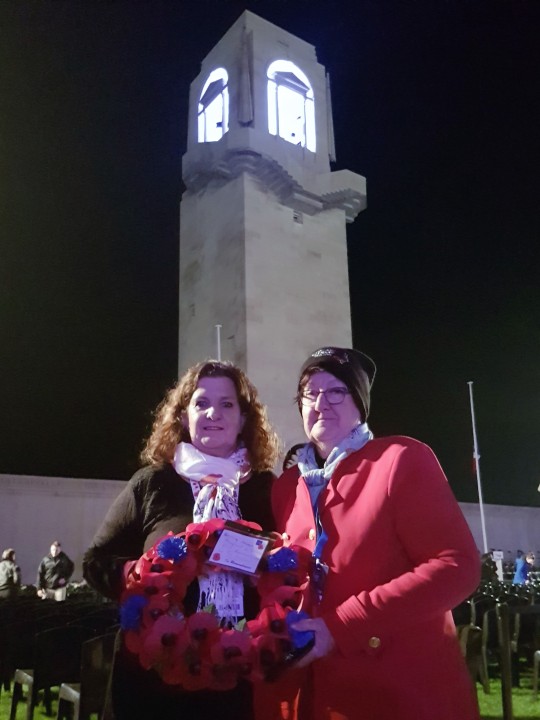
Waiting their turn to go up

Jo and Cec waiting for the family in blue to finish (on the big screen)
Finally, the service was over and surprisingly, instead of being whisked away by security, Prince Charles stayed around and chatted to the plebs. He didn't rush neither and genuinely seemed to want to be there. He outlasted the pollies. We didn't get close to him and made a bee line up the hill for breakfast at the Victoria Café. We did the same thing as last time and the food was good. If we timed it right, which we did, we would have time for breakfast and then work our way down to the French service at eight thirty.
A pleasant surprise awaited us while we were waiting to be served. Ex-Prime Minister and now back bencher, Tony Abbott arrived for a meal. Shane took the opportunity to introduce himself and have a brief word. Both commented about the significance of the morning and how moving it was. Shane commented about how the Somme is where it all happened and that this place should hold more significance on ANZAC day than Gallipoli. Tony agreed and mentioned that we also get on better with the French than the Turks. As quickly as the conversation had begun, it was over.

Enter the ex-PM
The French ceremony was a different affair. As expected, much more low key but every bit as important as ours. A decent crowd milled around to watch the proceedings, starting with the arrivals of the dignitaries, through a guard of honour manned by French firefighters with ceremonial axes and then the Australian armed forces.

Guard of Honour at the French ceremony

Yes, Prime Ministers
Speeches made and wreaths laid, the ceremony concluded. Everyone dispersed, us down to the end of the street with heaps of others for the shuttle back to Glisy. Back to the Volvo and back to Clairfaye. With our bags already pretty well packed, it was a case of checking the apartment, loading up the car and bidding farewell. As a parting gift, Benoît gave us a bottle of his red wine, produced locally from a private vineyard. The only identification was a sticker in French instead of a label. Dated 2005. Cecilia thanked him and in return gave him a beany from the service with the ANZAC emblem on it. We parted ways and headed toward Paris.
It was a slow trip to CDG as Thomas couldn't go over eighty due to the dodgy little tyre on his car. He did anyway, about a hundred clicks and managed well, but towards the end of the Motorway and nearing Paris, Shane found himself nodding off. The lack of sleep was getting the better of him. The thirty plus hours awake didn't seem to affect Thomas as much. We were travelling at over a hundred kilometres an hour so he pulled over and Jo drove the last part.
Once we left the Motorway, Shane, back in the driver’s seat, took a different turn than Thomas due to the GPS variations. With no service we struggled to contact each other. When we did, we decided to meet again at the Le Celtic in Le Thillay where we had started our journey a few days before. After meeting up in the car park across the road we set our sights on the airport and headed off. We followed each other for a while but were soon separated again.
To complicate matters, although the GPS gave an accurate location of where the Sixt return area was, getting there was a nightmare. There were so many turns available once in the airport, taking the wrong turn was inevitable. At one point, Shane stopped and asked a guy repairing the boom gates at the entry of somewhere. He told Shane to drive straight ahead and exit back onto the road that he was just on. The only thing was that at the other end of somewhere there was another boom gate and he couldn't get out. After a bit of yelling into a microphone the gate was raised. When we finally chose the right road, we ended up in a massive car park, the spiralling access roads leading us in circles, actually and metaphorically.
Finally, after what seemed and certainly was ages, we found the place, pulling up at the Sixt returns office. As we were to return the vehicle, Jo went to look for Thomas and Cecilia who were trying to locate us by phone calls, they were still lost. With stress levels at the extreme, Shane jumped into the car, collected Jo and went to find them, which we did, a bit of a way off from the Sixt office. Shane was meant to lead Tom back but drove like he was on the freeway and lost them. The F bomb was being used by Cecilia and Tom, we finally were reunited and unloaded.
There was no opportunity to wash the cars so they went back dirty. The dudes at Sixt didn't care, they backed it into a spot near the office and went over it for damage. There was only one mark on the Volvo but it was already there. They looked for damage on Tom's car, we told them about the punctured tyre and not about the damaged rim. It was the first thing they looked for.
With all luggage out we grabbed some airport trolleys caught the lift back down a couple of levels and straight outside to the taxi rank. There were a few cabs around but all seemed too small. A young woman who was there to organise the cabs asked a few questions and stood us to the side. There were a few dodgy cab drivers around, particularly an African who stalked us inside the terminal trying to get us into his minivan before we could even get to the rank. We ignored him. The woman ended up calling up for a minivan to jump the queue and take us all together. Seventy Euro for a memorable trip back to Paris by a maniac who reached speeds over a hundred kilometres an hour, weaving in and out of traffic and abused people beside him as we went. Anyway, we got there.

Excited by the trip from CDG
The driver dropped us off straight out front of our apartment where we would spend the next few days, 220 Rue de Rivoli. We immediately phoned our contact and was advised of the security number to get us through the oversized front door and into a courtyard. From there she met us and sorted us out getting up to the top floor (plus a couple) in the lift. After a few trips as it only held two at a time, we were at the apartment. In the roof space. The apartment was cosy to say the least. No dining room, only a small bench with stools. There was a bedroom with two singles on the bottom floor and a bedroom with a very tight double bed on the top. The toilet was downstairs next to the kitchen, no window and no vent or exhaust fan, equalled gross smells from the when well used, and the bathroom upstairs, joined by a very steep set of stairs. Break your neck type of steep. Care needed to be taken from the top bedroom as the doorway led straight onto the top step. An accident waiting to happen. The boys were in the room down stairs, Jo and Shane upstairs and Cecilia on the fold out couch. Once again Cecilia, Shane and Jo’s suitcases had to be kept down stairs and were squeezed under the little table and stools that was suppose to be a dining table.

Doorman from next door, not there to greet us
Once the person who greeted us had left, we headed straight out looking for a feed, Cec's shout. Jo, Beau and Cec went first, and while waiting for the rest in the foyer , were abused by an old French lady who demanded to know who they were. Glared at Beau, who was standing away from the girls and asked were we all together, and what they were doing in the foyer. Jo explained we were on holidays staying in an apartment and we were waiting for Hubby and other son. She demanded to know what number apartment we were staying in, we didn’t know and said the 6th floor somewhere near the stairs. She then said is it Airbnb, then went on to whinge about Airbnb in both English and French. Jo smiled sweetly and said “Je ne parlez francais je ne pas comprehend”. The old bat demanded to see our rental paperwork. Jo told her she didn’t have it on her and if it’s such a big deal to take it up with the owner as it wasn't our problem. Cecilia was quite stressed though and was terrified the lady was the owner of the apartment block or the caretaker. She was convinced we would get back from dinner and find our luggage out on the street. By the time the boys had arrived the old sheila was gone. Not that they would have done much. Probably copped it as well. Anyway, we made our way out of the front doors, walked left down the pathway and then left again. At the end of Rue de 29 Juliet was a shopping mall covered in glass. There wasn't much open, but to the right hand side was a sizable fruit market which ended up being just the thing for Cecilia. All the trip so far, she wanted some asperges or asparagus. She finally got what she wanted but paid an ungodly sum for them. They were huge, not like back home. She also bought the largest punnet of strawberries we have ever seen. Then after looking around the immediate area (our host recommended this area), we decided to have burgers at Razowskis, a local burger joint. Cecilia's shout. We sat down and studied the menu.
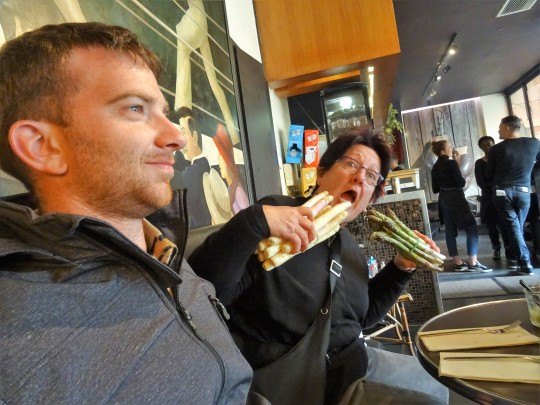
Eat me
The meal was good, as far as burgers were concerned but three hundred dollars for five burgers and beers was ludicrous. Cecilia insisted so that was that. Back to the apartment for an early night. Tomorrow, the Orsay.
0 notes
Text
Events 7.14
982 – King Otto II and his Frankish army were defeated by the Muslim army of al-Qasim at Cape Colonna, Southern Italy.
1223 – Louis VIII becomes King of France upon the death of his father, Philip II.
1420 – Battle of Vítkov Hill, decisive victory of Czech Hussite forces commanded by Jan Žižka against Crusade army led by Sigismund, Holy Roman Emperor.
1430 – Joan of Arc, taken by the Burgundians in May, is handed over to Pierre Cauchon, the bishop of Beauvais.
1596 – Anglo-Spanish War: English and Dutch troops sack the Spanish city of Cádiz before leaving the next day.
1769 – An expedition led by Gaspar de Portolá leaves its base in California and sets out to find the Port of Monterey (now Monterey, California).
1771 – Foundation of the Mission San Antonio de Padua in modern California by the Franciscan friar Junípero Serra.
1789 – Storming of the Bastille in Paris. This event escalates the widespread discontent into the French Revolution. Bastille Day is still celebrated annually in France.
1790 – Inaugural Fête de la Fédération is held to celebrate the unity of the French people and the national reconciliation.
1791 – Beginning of Priestley Riots (to 17 July) in Birmingham targeting Joseph Priestley as a supporter of the French Revolution.
1798 – The Sedition Act of 1798 becomes law in the United States making it a federal crime to write, publish, or utter false or malicious statements about the United States government.
1808 – The Finnish War: the Battle of Lapua was fought.
1853 – Opening of the first major US world's fair, the Exhibition of the Industry of All Nations in New York City.
1865 – The first ascent of the Matterhorn is completed by Edward Whymper and his party, four of whom die on the descent.
1874 – The Chicago Fire of 1874 burns down 47 acres of the city, destroying 812 buildings, killing 20, and resulting in the fire insurance industry demanding municipal reforms from Chicago's city council.
1881 – American outlaw Billy the Kid is shot and killed by Sheriff Pat Garrett in the Maxwell House at Fort Sumner, New Mexico.
1900 – Armies of the Eight-Nation Alliance capture Tientsin during the Boxer Rebellion.
1902 – The Campanile in St Mark's Square, Venice collapses, also demolishing the loggetta.
1911 – Harry Atwood, an exhibition pilot for the Wright brothers, is greeted by President Taft after he lands his aeroplane on the South Lawn of the White House, having flown from Boston.
1915 – Beginning of the McMahon–Hussein Correspondence between Hussein bin Ali, Sharif of Mecca and the British official Henry McMahon concerning the Arab Revolt against the Ottoman Empire.
1916 – Battle of Delville Wood begins as an action within the Battle of the Somme, lasting until 3 September 1916.
1933 – In a decree called the Gleichschaltung, Adolf Hitler abolishes all German political parties except the Nazis.
1933 – Nazi eugenics programme begins with the proclamation of the Law for the Prevention of Hereditarily Diseased Offspring requiring the compulsory sterilization of any citizen who suffers from alleged genetic disorders.
1943 – In Diamond, Missouri, the George Washington Carver National Monument becomes the first United States National Monument in honor of an African American.
1948 – Palmiro Togliatti, leader of the Italian Communist Party, is shot and wounded near the Italian Parliament.
1950 – Korean War: beginning of the Battle of Taejon.
1951 – Ferrari take their first Formula One grand prix victory at the British Grand Prix at Silverstone.
1957 – Rawya Ateya takes her seat in the National Assembly of Egypt, thereby becoming the first female parliamentarian in the Arab world.
1958 – In the 14 July Revolution in Iraq, the monarchy is overthrown by popular forces led by Abd al-Karim Qasim, who becomes the nation's new leader.
1960 – Jane Goodall arrives at the Gombe Stream Reserve in present-day Tanzania to begin her study of chimpanzees in the wild.
1965 – Mariner 4 flyby of Mars takes the first close-up photos of another planet. The photographs take approximately six hours to be transmitted back to Earth.
1983 – Mario Bros. is released in Japan, beginning the popular Super Mario Bros franchise.
2002 – French president Jacques Chirac escapes an assassination attempt from Maxime Brunerie during a Bastille Day parade at Champs-Élysées.
2013 – Dedication of statue of Rachel Carson, a sculpture named for the environmentalist, in Woods Hole, Massachusetts.
2015 – NASA's New Horizons probe performs the first flyby of Pluto, and thus completes the initial survey of the Solar System.
2016 – A man ploughs a truck into a Bastille Day celebration in Nice, France, killing 86 people and injuring another 434 before being shot by police.
0 notes
Photo

#Historical roots and #heritage of Hertz in #SouthernAfrica. - 1919: Delville Wood Motors Car Hire Two survivors of World War 1’s Battle of Delville Wood join forces to start South Africa’s (SA) first car rental company. - 1930s: Robert Murray buys the company andchanges the name to African Car Hire. - 1950s: Hertz makes its entry ... Hertz grants Murray the franchise for SA. - 1986: Political pressure … Hertz International supportsrequest for US businesses to disinvest from SA. - 1997: Hertz makes its return … At the invitation of Nelson Mandela, Hertz’s return to SA is formalised. #AfricaMonth #KnowYourHistory #ShapeYourFuture
2 notes
·
View notes
Text
The Black Watch and the Delville Wood Lament
The Black Watch and the Delville Wood Lament
If you think you are tough, try taking up bag-pipes again after been wounded through both cheeks – now that’s eye-watering tough. Men and women of the 1st World War generation were are cut from an entirely different cloth, and Bag Pipers in particular are something else,
With South Africans honouring the centenary of World War 1, we should remember this particular action and this man – as this is…
View On WordPress
#Battle of Delville Wood#Battle of the Somme#Delville Wood#Sandy Grieves#The Black Watch#Transvaal Scottish
0 notes